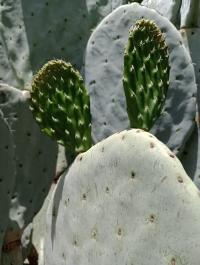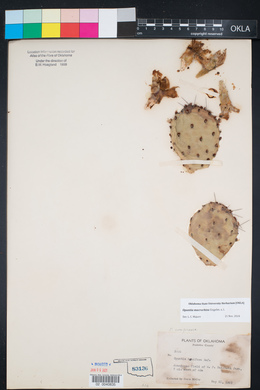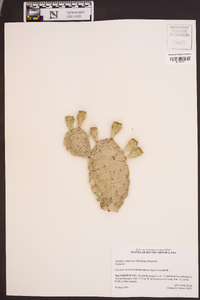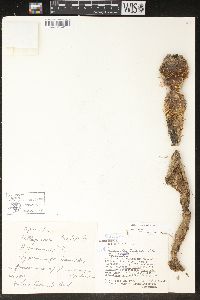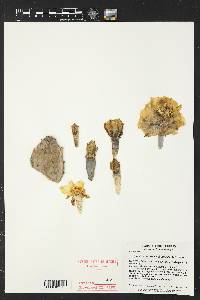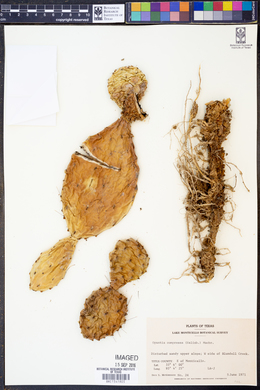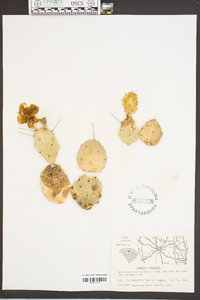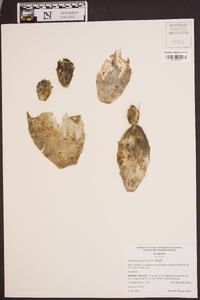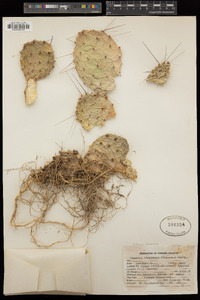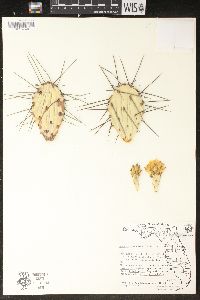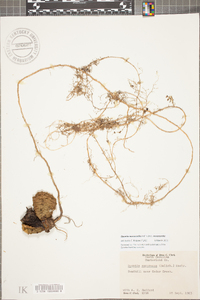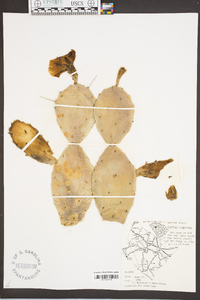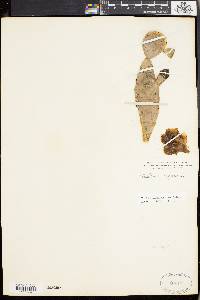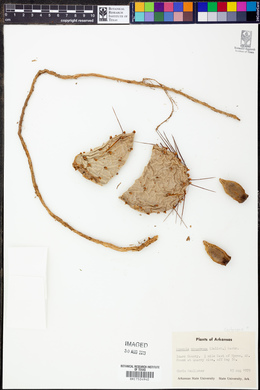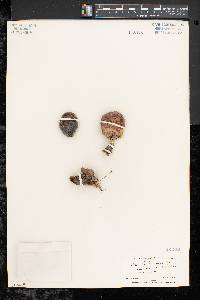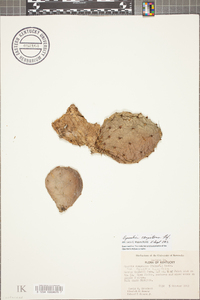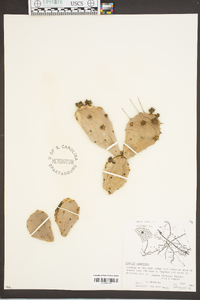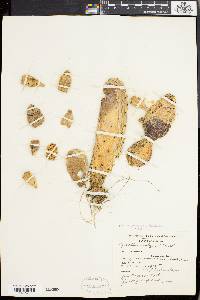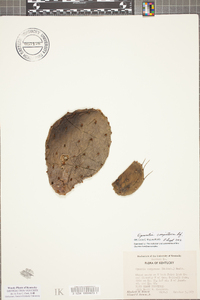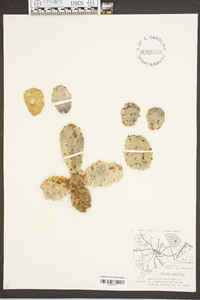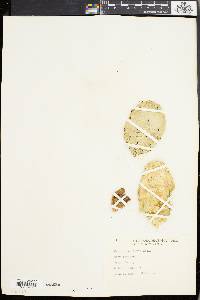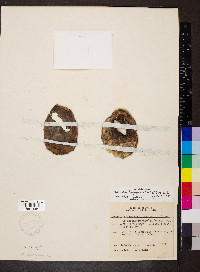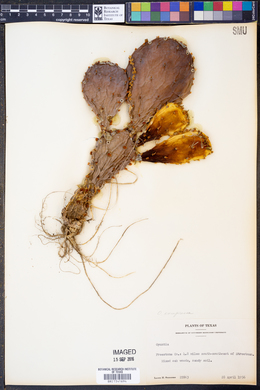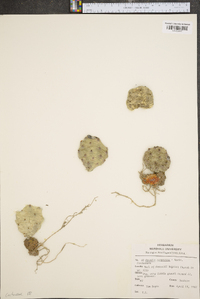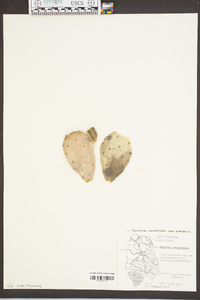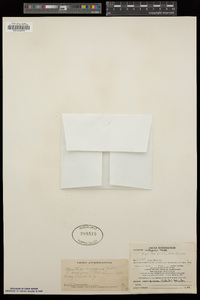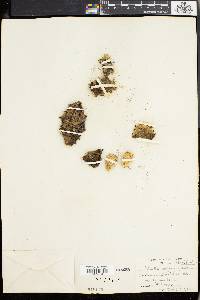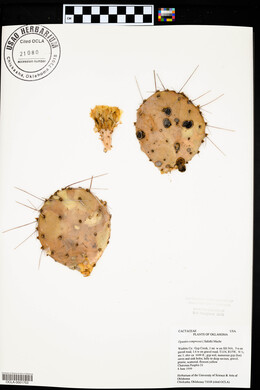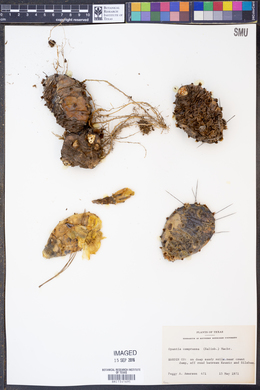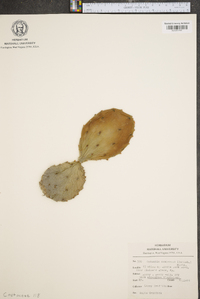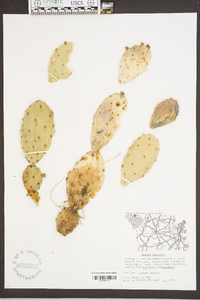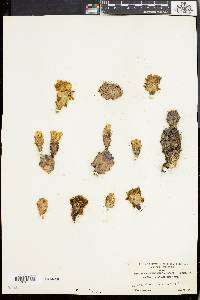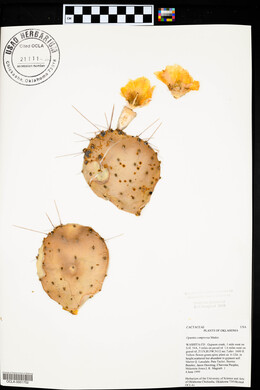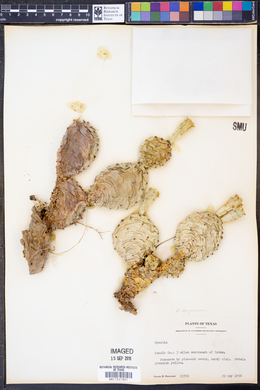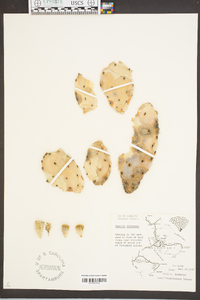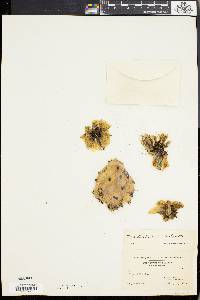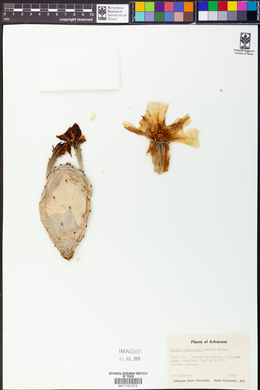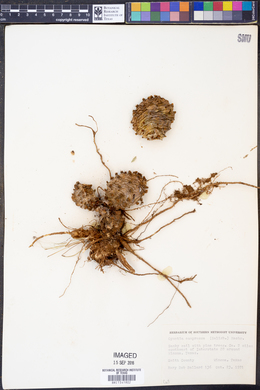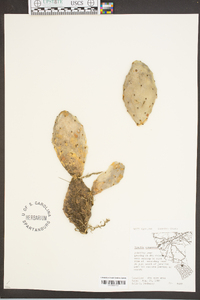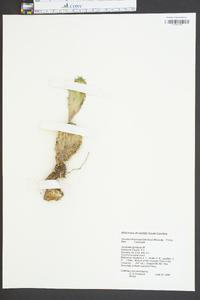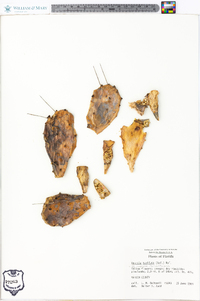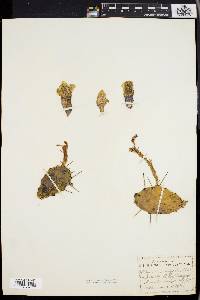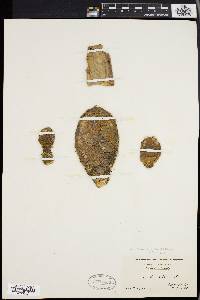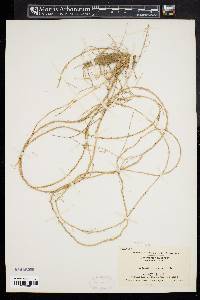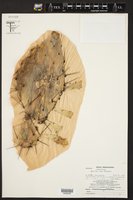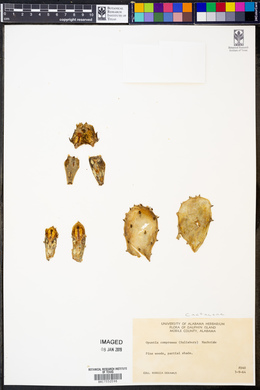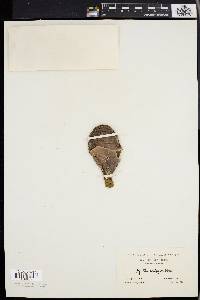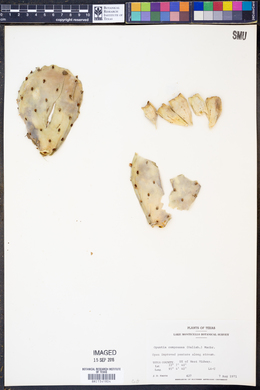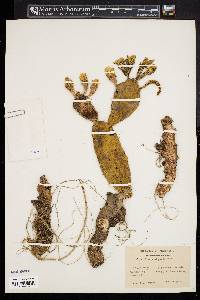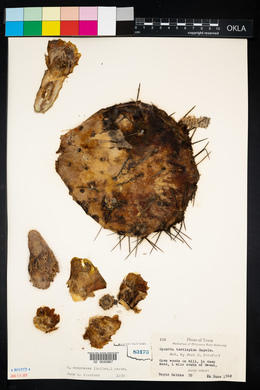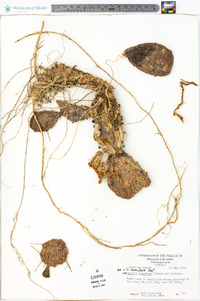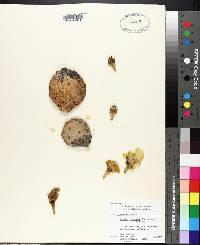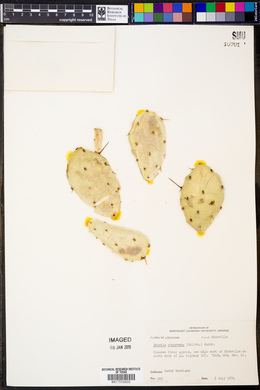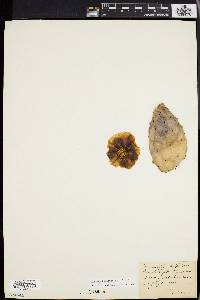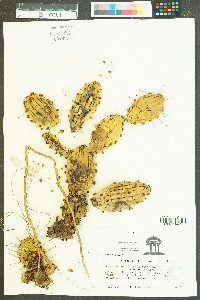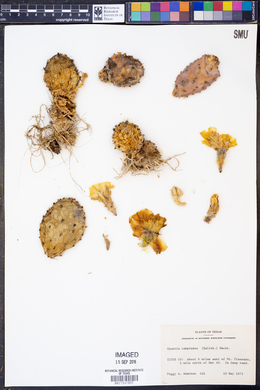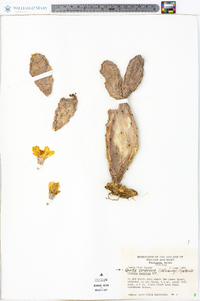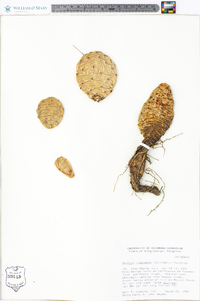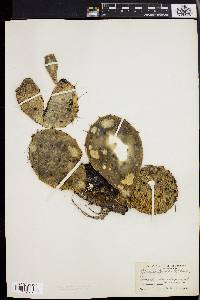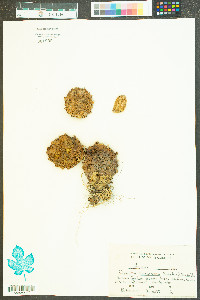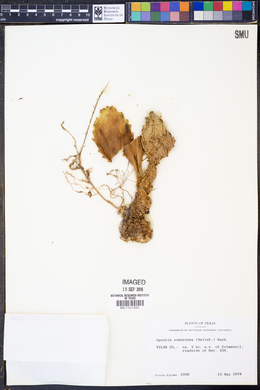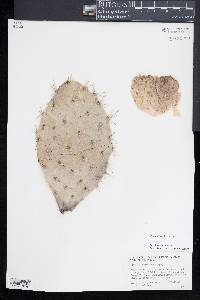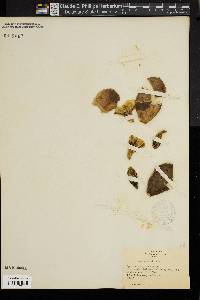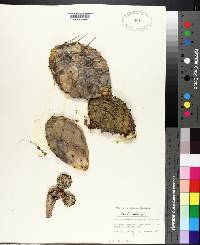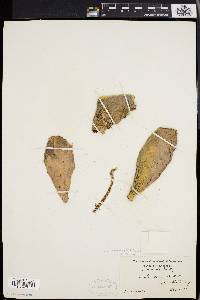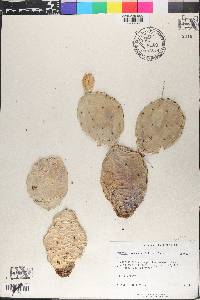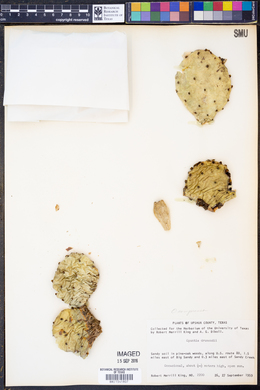Opuntia ficus-indica
|
|
|
|
Family: Cactaceae
Indian-Fig, more...tuna cactus, indian fig (es: nopal de castilla, tuna de castilla)
[Cactus ficus-indica L., moreOpuntia compressa J.F. Macbr., Opuntia incarnadilla , Opuntia maxima Mill., Opuntia opuntia Coult., Opuntia paraguayensis K. Schum., Opuntia vulgaris P. Mill., Platyopuntia apurimacensis F. Ritter, Platyopuntia cordobensis (Speg.) F. Ritter] |
Trees, 3-6 m; trunk to 30-45 cm diam. Stem segments green, broadly oblong to ovate to narrowly elliptic, (20-)4-60 × 2-3+ cm, low tuberculate; areoles 7-11 per diagonal row across midstem segment, rhombic to subcircular, 2-4(-5) mm diam.; wool brown. Spines 1-6 per areole, absent or very highly reduced, or in marginal to nearly all areoles, erect to spreading, whitish, tan, or brown, setaceous only or setaceous and subulate, straight to slightly curved, basally angular-flattened, 1-10(-40) mm; 0-2 small bristlelike deflexed spines to 5 mm. Glochids along adaxial margin of areole and small, inconspicuous tuft, yellowish, aging brown, less than 2 mm. Flowers: inner tepals yellow to orange throughout, 25-50 mm; filaments and anthers yellow; style bright red; stigma lobes yellow. Fruits yellow to orange to purple, 50-100 × 40-90 mm, fleshy to ± juicy, glabrous, usually spineless; areoles 45-60, evenly distributed on fruit. Seeds pale tan, subcircular, 4-5 mm diam., warped; girdle protruding to 1 mm. 2n = 88. Flowering spring (Apr). Coastal chaparral, sage scrub, arid uplands, washes, canyons, disturbed sites; 0-300 m; introduced; Ariz., Calif.; Mexico. R. P. Wunderlin (1998) listed this taxon in Florida, but I have not seen specimens. Opuntia ficus-indica, cultivated nearly worldwide, is presumed to be a native of Mexico, but is definitely known only from cultivation or escapes from cultivation. The species has been used for cattle feed, ornament, and fuel. As human food, the young stem segments, 'nopalitos,' are eaten as salad or pickled as a vegetable, and the large delicious fruits, 'tunas,' are enjoyed in tropical and subtropical regions worldwide. This species probably originated through selection by native peoples of Mexico for spineless forms of Opuntia streptacantha (also 2n = 88) to ease the culturing and collection of cochineal scale insects for their red dye. Numerous cultivar names are known. Naturalized Opuntia ficus-indica (octoploid, spiny morphotype) is known to hybridize in central California with O. phaeacantha (hexaploid), forming a heptaploid with usually intermediate morphology.
Plant: tree to 6 m tall, with trunk to 30 cm in diameter. PADS green, glabrous, elliptic, oblong to obovate to lanceolate, 25-60+ cm long, 15-40 cm broad. AREOLES 6-9 in a diagonal row across mid-pad, rhombic to subcircular, 2-4(-5) mm in diameter; wool brown Leaves: SPINES absent or very highly reduced, or in marginal to nearly all areoles, whitish to tan to ± brown, bristle-like only or bristle-like and subulate, these straight to slightly curved, spreading basally angular-flattened, 1-6 per areole, 0.1-4 cm; 0-2 small, basal bristle-like deflexed spines to 0.5 cm long. GLOCHIDS yellowish, aging brown, on distal margin of areole, in an inconspicuous tuft, less than 1.5 mm long Flowers: inner tepals yellow to orange, 2.5-5 cm long; filaments yellow; style bright red; fresh stigmas yellow Fruit: FRUITS: yellow to orange to ± purple, usually spineless, fleshy to ± juicy, edible, 5-10 cm long, 4-9 cm in diameter; areoles 36-58, well distributed on fruit. SEEDS pale tan, subcircular, 4-5 mm in diameter, warped; girdle only slightly protruding Misc: Sandy to gravelly desert soils, associated with human activity; 250-750 m (900-2500 ft); Apr REFERENCES: Pinkava, Donald J. Cactaceae. 2003. J. Ariz. - Nev. Acad. Sci. Volume 35(2). Benson 1982, FNA 2003, Pinkava 2003 Common Name: Barbary fig Duration: Perennial Protected Status: No status in Arizona. Spines: Spines absent or highly reduced with 1-6 per areole or in marginal or nearly all areoles, the spines are erect to spreading and whitish, tan, or brown, they are straight to slightly curved and basally angular-flattened, 1-10 mm with 0-2 small bristlelike deflexed spines that reach 5 mm, the glochids are numerous and yellow but early deciduous and found along adaxial margin or areole but generally less than 2 mm. Flowers: Flower 5-7 cm diameter with inner tepals that are yellow to orange throughout and 25-50 mm, the filaments and anthers are yellow, the style bright red and bulging to 3 mm diameter. Fruits: Fruit yellow, orange, red, or even purplish-red and 50-100 mm long by 40-90 mm in diameter, fleshy to juicy and usually spineless, they are glabrous and the fruit is persistent for several months. Ecology: Found in coastal chaparral, sage scrub, arid uplands, washes, canyons, and disturbed sites, on sandy to gravelly desert soils from sea level to 1,000 ft (305 m), flowers in April. Notes: Cultivated for its fruit and pads this plant is widespread in many regions of the world. This species is considered a pest in Australia and South Africa. Benson 1982 says that O. ficus-indica is presumed to be native to Mexico, and is known to hybridize with native varieties of O. littoralis. FNA 2003 says it is also known to hybridize in California with O. phaeacantha. Etymology: Opuntia from ancient root puncti for prickled, while ficus-indica means Indian fig. Synonyms: Numerous, see Tropicos Editor: LCrumbacher, 2010 |


